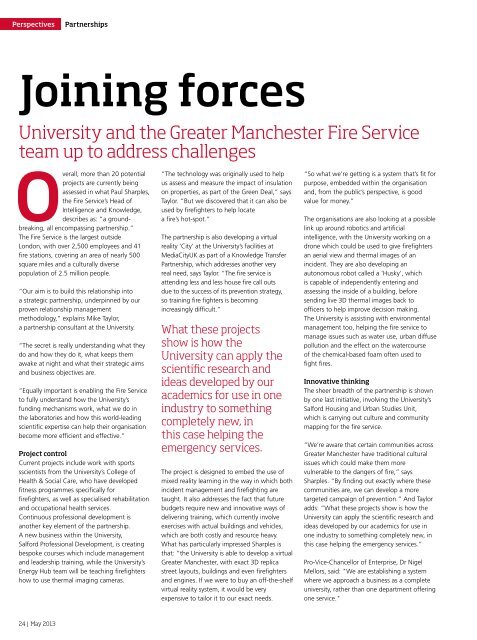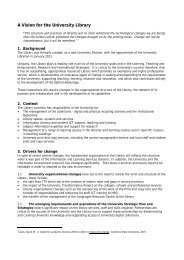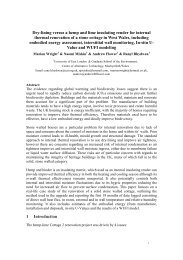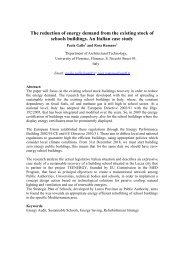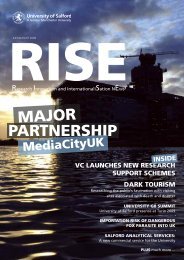Download a copy (pdf) - University of Salford
Download a copy (pdf) - University of Salford
Download a copy (pdf) - University of Salford
You also want an ePaper? Increase the reach of your titles
YUMPU automatically turns print PDFs into web optimized ePapers that Google loves.
PerspectivesPartnershipsJoining forces<strong>University</strong> and the Greater Manchester Fire Serviceteam up to address challengesOverall, more than 20 potentialprojects are currently beingassessed in what Paul Sharples,the Fire Service’s Head <strong>of</strong>Intelligence and Knowledge,describes as: “a groundbreaking,all encompassing partnership.”The Fire Service is the largest outsideLondon, with over 2,500 employees and 41fire stations, covering an area <strong>of</strong> nearly 500square miles and a culturally diversepopulation <strong>of</strong> 2.5 million people.“Our aim is to build this relationship intoa strategic partnership, underpinned by ourproven relationship managementmethodology,” explains Mike Taylor,a partnership consultant at the <strong>University</strong>.“The secret is really understanding what theydo and how they do it, what keeps themawake at night and what their strategic aimsand business objectives are.“Equally important is enabling the Fire Serviceto fully understand how the <strong>University</strong>’sfunding mechanisms work, what we do inthe laboratories and how this world-leadingscientific expertise can help their organisationbecome more efficient and effective.”Project controlCurrent projects include work with sportssscientists from the <strong>University</strong>’s College <strong>of</strong>Health & Social Care, who have developedfitness programmes specifically forfirefighters, as well as specialised rehabilitationand occupational health services.Continuous pr<strong>of</strong>essional development isanother key element <strong>of</strong> the partnership.A new business within the <strong>University</strong>,<strong>Salford</strong> Pr<strong>of</strong>essional Development, is creatingbespoke courses which include managementand leadership training, while the <strong>University</strong>’sEnergy Hub team will be teaching firefightershow to use thermal imaging cameras.“The technology was originally used to helpus assess and measure the impact <strong>of</strong> insulationon properties, as part <strong>of</strong> the Green Deal,” saysTaylor. “But we discovered that it can also beused by firefighters to help locatea fire’s hot-spot.”The partnership is also developing a virtualreality ‘City’ at the <strong>University</strong>’s facilities atMediaCityUK as part <strong>of</strong> a Knowledge TransferPartnership, which addresses another veryreal need, says Taylor. “The fire service isattending less and less house fire call outsdue to the success <strong>of</strong> its prevention strategy,so training fire fighters is becomingincreasingly difficult.”What these projectsshow is how the<strong>University</strong> can apply thescientific research andideas developed by ouracademics for use in oneindustry to somethingcompletely new, inthis case helping theemergency services.The project is designed to embed the use <strong>of</strong>mixed reality learning in the way in which bothincident management and firefighting aretaught. It also addresses the fact that futurebudgets require new and innovative ways <strong>of</strong>delivering training, which currently involveexercises with actual buildings and vehicles,which are both costly and resource heavy.What has particularly impressed Sharples isthat: “the <strong>University</strong> is able to develop a virtualGreater Manchester, with exact 3D replicastreet layouts, buildings and even firefightersand engines. If we were to buy an <strong>of</strong>f-the-shelfvirtual reality system, it would be veryexpensive to tailor it to our exact needs.“So what we’re getting is a system that’s fit forpurpose, embedded within the organisationand, from the public’s perspective, is goodvalue for money.”The organisations are also looking at a possiblelink up around robotics and artificialintelligence, with the <strong>University</strong> working on adrone which could be used to give firefightersan aerial view and thermal images <strong>of</strong> anincident. They are also developing anautonomous robot called a 'Husky', whichis capable <strong>of</strong> independently entering andassessing the inside <strong>of</strong> a building, beforesending live 3D thermal images back to<strong>of</strong>ficers to help improve decision making.The <strong>University</strong> is assisting with environmentalmanagement too, helping the fire service tomanage issues such as water use, urban diffusepollution and the effect on the watercourse<strong>of</strong> the chemical-based foam <strong>of</strong>ten used t<strong>of</strong>ight fires.Innovative thinkingThe sheer breadth <strong>of</strong> the partnership is shownby one last initiative, involving the <strong>University</strong>’s<strong>Salford</strong> Housing and Urban Studies Unit,which is carrying out culture and communitymapping for the fire service.“We’re aware that certain communities acrossGreater Manchester have traditional culturalissues which could make them morevulnerable to the dangers <strong>of</strong> fire,” saysSharples. “By finding out exactly where thesecommunities are, we can develop a moretargeted campaign <strong>of</strong> prevention.” And Tayloradds: “What these projects show is how the<strong>University</strong> can apply the scientific research andideas developed by our academics for use inone industry to something completely new, inthis case helping the emergency services.”Pro-Vice-Chancellor <strong>of</strong> Enterprise, Dr NigelMellors, said: "We are establishing a systemwhere we approach a business as a completeuniversity, rather than one department <strong>of</strong>feringone service."24 | May 2013


